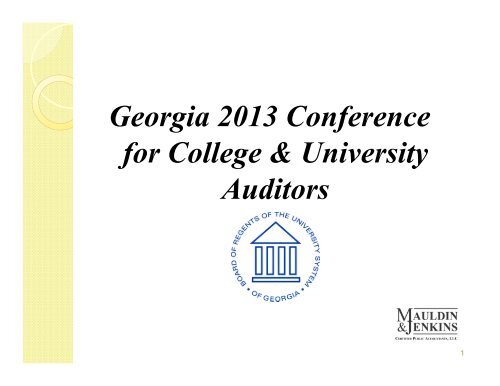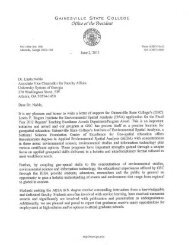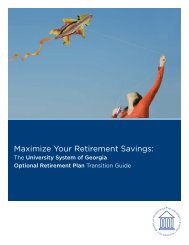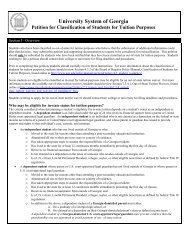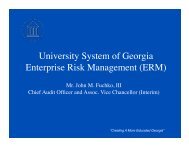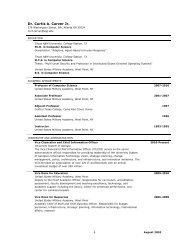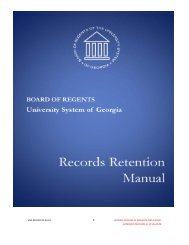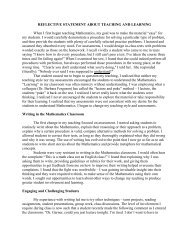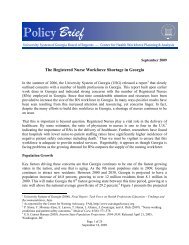Current Audit Issues Relating to Colleges/Universities and Their ...
Current Audit Issues Relating to Colleges/Universities and Their ...
Current Audit Issues Relating to Colleges/Universities and Their ...
You also want an ePaper? Increase the reach of your titles
YUMPU automatically turns print PDFs into web optimized ePapers that Google loves.
Georgia 2013 Conference<br />
for College & University<br />
<strong>Audit</strong>ors<br />
1
Jeff Fuci<strong>to</strong>,CPA<br />
770-541-5434<br />
jfuci<strong>to</strong>@mjcpa.com<br />
Aleisa Howell,CPA<br />
770-980-2364<br />
ahowell@mjcpa.com<br />
2
Agenda<br />
• Introductions<br />
• GASB Statement No. 60<br />
• IRS <strong>Colleges</strong> <strong>and</strong> <strong>Universities</strong> Compliance<br />
Project<br />
• Accounting for PPVs’<br />
• Fraud<br />
• Topics <strong>Colleges</strong> <strong>and</strong> <strong>Universities</strong> should be<br />
aware of related <strong>to</strong> Foundations<br />
• Questions<br />
3
GASB Statement No. 60<br />
Accounting <strong>and</strong> Financial Reporting for<br />
Service Concession Arrangements<br />
4
Issued<br />
November<br />
2010<br />
Effective for<br />
periods<br />
beginning after<br />
December 15,<br />
2011
Service Concession<br />
Arrangements<br />
• Statement addresses service concession<br />
arrangements (SCAs)<br />
• SCAs are a type of public-private or<br />
public-public partnership<br />
• The term public-private partnership is<br />
used <strong>to</strong> refer <strong>to</strong> a variety of:<br />
◦ Service arrangements (outsourcing a service)<br />
◦ Management arrangements (outsourcing<br />
mgmt)<br />
◦ SCAs (last type before being a privatization)<br />
6
Service Concession<br />
Arrangements<br />
• http://www.gasb.org/cs/BlobServerblobk<br />
ey=id&blobwhere=1175822186062&blob<br />
header=application%2Fpdf&blobcol=urld<br />
ata&blobtable=MungoBlobs<br />
7
Accounting <strong>and</strong> Financial Reporting<br />
For Service Concession Arrangements<br />
What is a service concession arrangement<br />
•Public-private or public-public partnership<br />
•An arrangement between a transferor (a government) <strong>and</strong> an opera<strong>to</strong>r<br />
(governmental or nongovernmental) in which:<br />
1) the transferor conveys <strong>to</strong> an opera<strong>to</strong>r the right <strong>and</strong> related obligation <strong>to</strong><br />
provide public services through the operation of a capital asset in exchange<br />
for significant consideration, such as an up-front payment, installment<br />
payments, a new facility (constructed by the opera<strong>to</strong>r), or improvements <strong>to</strong><br />
an existing facility<br />
2) the opera<strong>to</strong>r collects <strong>and</strong> is compensated by fees from third parties<br />
8
Benefits of SCAs<br />
• May provide government with the ability <strong>to</strong> leverage<br />
existing infrastructure <strong>and</strong> other public assets <strong>to</strong><br />
generate additional resources in the form of up-front<br />
payments from the opera<strong>to</strong>r for the right <strong>to</strong> operate<br />
such assets<br />
• May be used <strong>to</strong> facilitate construction <strong>and</strong> financing<br />
of new infrastructure <strong>and</strong> other public assets <strong>and</strong><br />
transfer the risks associated with their construction<br />
<strong>and</strong> maintenance <strong>to</strong> a private entity<br />
• May be used <strong>to</strong> provide services <strong>to</strong> the general<br />
populace in a more efficient <strong>and</strong> cost-effective<br />
manner<br />
9
Service Concession Arrangements<br />
Transferor Accounting:<br />
◦ If facility associated with the SCA is an existing facility—<br />
transferor should continue <strong>to</strong> report the facility as a capital asset<br />
◦ If facility associated with the SCA is a new facility, purchased or<br />
constructed by the opera<strong>to</strong>r, or an existing facility that has been<br />
improved by the opera<strong>to</strong>r—transferor should report:<br />
• The new facility or the improvement as a capital asset at fair<br />
value when it is placed in operation,<br />
• Any contractual obligations as liabilities, <strong>and</strong><br />
• A corresponding deferred inflow of resources equal <strong>to</strong> the<br />
difference between the fair value of the asset <strong>and</strong> the liabilities<br />
◦ There is no booking of construction in progress—cost/benefit concerns<br />
10
Service Concession Arrangements<br />
Transferor Accounting (continued):<br />
◦ A transferor should recognize a liability for certain obligations<br />
<strong>to</strong> sacrifice financial resources under the terms of the<br />
arrangement. Liabilities associated with the SCA should be<br />
recorded at their PRESENT VALUE if the obligation is<br />
significant <strong>and</strong> meets either of the following criteria:<br />
• Contractual obligations that directly relate <strong>to</strong> the facility (for<br />
example, obligations for capital improvements, insurance,<br />
or maintenance on the facility)<br />
• Contractual obligations that relate <strong>to</strong> a commitment made<br />
by the transferor <strong>to</strong> maintain a minimum or specific level of<br />
service in connection with the operation of the facility (for<br />
example, providing a specific level of police <strong>and</strong> emergency<br />
services for the facility or a minimum level of maintenance<br />
<strong>to</strong> areas surrounding the facility)<br />
11
Service Concession Arrangements<br />
Transferor Accounting (continued):<br />
◦ After initial measurement, the capital asset is subject <strong>to</strong><br />
existing requirements for depreciation, impairment, <strong>and</strong><br />
disclosures<br />
• The capital asset should not be depreciated if the arrangement requires<br />
the opera<strong>to</strong>r <strong>to</strong> return the facility <strong>to</strong> the transferor in its original or an<br />
enhanced condition<br />
• The corresponding deferred inflow of resources should be reduced <strong>and</strong><br />
revenue should be recognized in a systematic <strong>and</strong> rational manner over<br />
the term of the arrangement<br />
• If a liability is recorded <strong>to</strong> reflect a contractual obligation, the liability<br />
should be reduced as the transferor’s obligations are satisfied. When<br />
the obligation is satisfied, a deferred inflow should be reported <strong>and</strong> the<br />
related revenue should be recognized in a systematic <strong>and</strong> rational<br />
manner over the term of the arrangement<br />
◦ Improvements made <strong>to</strong> the facility by the opera<strong>to</strong>r during the<br />
term of the SCA should be capitalized as they are made <strong>and</strong> are<br />
subject <strong>to</strong> the requirements for depreciation, impairment, <strong>and</strong><br />
disclosures<br />
12
Service Concession Arrangements<br />
Transferor Accounting (continued):<br />
◦ If an SCA requires up-front or installment payments<br />
from the opera<strong>to</strong>r, the transferor should report:<br />
• The up-front payment or present value of installment<br />
payments as an asset<br />
• Any contractual obligations as liabilities, <strong>and</strong><br />
• A deferred inflow of resources equal <strong>to</strong> the difference between<br />
the two<br />
◦ Revenue should be recognized as the deferred inflow<br />
of resources is reduced. This revenue should be<br />
recognized in a systematic <strong>and</strong> rational manner over<br />
the term of the arrangement<br />
13
Service Concession Arrangements<br />
Governmental Opera<strong>to</strong>r Accounting:<br />
•The governmental opera<strong>to</strong>r would report an<br />
intangible asset for the right <strong>to</strong> access the facility <strong>and</strong><br />
collect third-party fees from its operation at cost (for<br />
example, the amount of an up-front payment or the<br />
cost of construction of or improvements <strong>to</strong> the facility)<br />
•Amortized over the term of the arrangement in a<br />
systematic <strong>and</strong> rational manner<br />
•Improvements made <strong>to</strong> the facility during the<br />
arrangement would increase the governmental<br />
opera<strong>to</strong>r’s intangible asset if the improvements<br />
increase the capacity or efficiency of the facility<br />
14
Service Concession Arrangements<br />
Governmental Opera<strong>to</strong>r Accounting:<br />
•If the arrangement requires a facility <strong>to</strong> be returned<br />
in a specified condition <strong>and</strong> information is prominent<br />
that indicates the facility is not in the specific<br />
condition, <strong>and</strong> the cost <strong>to</strong> res<strong>to</strong>re the facility <strong>to</strong> that<br />
condition is reasonably estimable, then a liability, <strong>and</strong><br />
generally <strong>and</strong> expense <strong>to</strong> res<strong>to</strong>re the facility should<br />
be reported<br />
15
IRS <strong>Colleges</strong> <strong>and</strong><br />
<strong>Universities</strong> Compliance<br />
Project<br />
16
IRS <strong>Colleges</strong> <strong>and</strong> <strong>Universities</strong> Compliance Project<br />
• Exempt Organizations officials released the final<br />
report (posted April 25, 2013, Executive<br />
Summary revised May 2, 2013) on its tax-exempt<br />
colleges <strong>and</strong> universities compliance project.<br />
• The multi-year project, begun in 2008, included a<br />
questionnaire sent <strong>to</strong> 400 colleges <strong>and</strong> universities<br />
<strong>and</strong> subsequent audits of 34 selected academic<br />
institutions. The final report focuses on the results<br />
of these examinations, especially in the areas of<br />
unrelated business income <strong>and</strong> executive<br />
compensation.<br />
17
IRS <strong>Colleges</strong> <strong>and</strong> <strong>Universities</strong> Compliance Project<br />
• http://www.irs.gov/Charities-&-Non-<br />
Profits/<strong>Colleges</strong>-<strong>and</strong>-<strong>Universities</strong>-Compliance-<br />
Project<br />
• http://agb.org/news/2013-05/agb-nacubo-alertirs-issues-final-report-college-<strong>and</strong>-universitycompliance-project<br />
18
PPV ACCOUNTNG<br />
• What we are seeing vs. proper accounting<br />
19
PPV ACCOUNTING (taken from year end<br />
audi<strong>to</strong>r training with Ben Riden)<br />
• Institution’s Accounting Implications<br />
‣ Institution should record as Capital Asset <strong>and</strong> Lease Purchase obligation when project is complete. From an accounting<br />
perspective, completion is deemed <strong>to</strong> be when “Certificate of Occupancy” is received.<br />
‣ The Capital Asset <strong>and</strong> the related lease purchase obligation (liability) are recorded at the lesser of:<br />
1) Fair market value of the asset at the inception of the lease, or<br />
2) Present Value of the minimum lease payments.<br />
We have his<strong>to</strong>rically used sources/uses of funds from the bond documents <strong>to</strong> make these calculations. However, in recent<br />
conversations with representatives of CPA firms conducting some of our foundation audits, it has been suggested that we<br />
use the actual project costs, which is essentially the same as the present value of the minimum lease payments, <strong>to</strong> record<br />
as our Capital asset value <strong>and</strong> lease liability. This will not change our <strong>to</strong>tal rent payments over the life of the lease, but it<br />
will change the distribution between principal <strong>and</strong> interest <strong>and</strong> will be more in line with how foundations are reporting the<br />
lease receivable.<br />
The ancillary costs included in the sources <strong>and</strong> uses will no longer be considered part of our project costs. However, for<br />
projects already on the books, we are not suggesting any changes <strong>to</strong> capitalized balances or debt schedules because we<br />
don’t believe there would be any significant effect on the financial statements since there would be no change <strong>to</strong> overall net<br />
asset balances.<br />
‣ The basic rental payments, along with the lessee’s incremental borrowing rate are used <strong>to</strong> create lease purchase<br />
debt/liability schedules for the institutions. A portion of the rental payment is considered principal reduction with the<br />
remainder of the payment recognized as interest expense.<br />
‣ In many situations, the first year’s bond payments are covered by funds held in the Capitalized interest account at the<br />
Foundation’s trustee. This was done <strong>to</strong> allow schools <strong>to</strong> build cash reserves from fees during the first year of the project.<br />
In those cases the institution’s actual cash payments are reduced, but the interest expense should be recorded for the full<br />
amount <strong>and</strong> the principal of the debt will be increased because interest is effectively being financed in the transaction.<br />
‣ Facility projects are designed <strong>and</strong> fees are assessed with the intention of generating 5% coverage ratio (cash reserve) for<br />
each project. Any cash reserves generated should stay with the project <strong>and</strong> are not intended <strong>to</strong> be used <strong>to</strong> facilitate costs of<br />
other projects.<br />
‣ The additional rental payments paid <strong>to</strong> the Foundation for R&R purposes are considered maintenance expense for the<br />
institutions <strong>and</strong> do not affect the Capital Asset or lease purchase calculations.
PPV ACCOUNTNG<br />
Institution’s Accounting Implications:<br />
‣ GHEFA projects are subject <strong>to</strong> funding limitations authorized by legislature.<br />
‣ Accounting <strong>and</strong> reporting is basically the same for GHEFA projects as with normal PPV<br />
projects.<br />
‣ On some GHEFA projects, institutions forward fund some initial project costs that will<br />
eventually be captured by the Foundation <strong>and</strong> that will be reimbursed. Institutions would<br />
normally reflect these costs as prepaid items.<br />
‣ For GHEFA projects, just as with GSFIC projects, if the institution has only received a letter of<br />
intent from GSFIC <strong>to</strong> sell bonds, but the bonds have not been sold, the institution cannot record a<br />
prepaid. This creates accounting issues for the institutions, because in that scenario, the school has<br />
<strong>to</strong> record the initial project costs as their own.<br />
‣ GHEFA managers have also provided a mechanism whereby institutions may place on deposit with<br />
the Foundation, institutional funds that will be used on the project. These funds are supposed <strong>to</strong> be<br />
used only for “removable capital items” (equipment). Institutions should record the expenditure of<br />
these funds as Construction in Progress until the Certificate of Occupancy is received on the project,<br />
then the costs should be moved <strong>to</strong> permanent capital assets.<br />
‣ Note: State law specifically prohibits capital improvements <strong>to</strong> leased assets, so no institutional funds should<br />
be used <strong>to</strong> make permanent capital improvements <strong>to</strong> an asset where the State/Institution does not hold title.
PPV ACCOUNTING<br />
Foundation’s Accounting Implications:<br />
‣Foundation carries original bond debt (debt <strong>to</strong> bond<br />
holders) until debt is serviced.<br />
‣Foundation should record the asset as an Investment in<br />
Capital lease.<br />
‣ Foundation should not carry the property as a Capital Asset after<br />
“Certificate of Occupancy” has been provided <strong>to</strong> institution.<br />
‣ Foundation’s Investment in Capital Lease should mirror what the<br />
Institution is carrying as Lease Purchase liability (debt).<br />
Therefore, as the Institution’s lease liability reduces each year, the<br />
Foundation’s Investment in the Capital Lease should also reduce.<br />
‣ As mentioned on the previous slide, institutions may place funds<br />
on deposit with the Foundation. The Foundation owns the bank<br />
accounts where the funds are held, therefore, the Foundation<br />
should record these funds in a “fiduciary/trust” capacity.
PPV ACCOUNTING<br />
• Foundation Entries<br />
◦ Record Bond Transaction<br />
Restricted Cash Project Fund 18,138,249.88<br />
Revenue Bonds Payable 21,845,000.00<br />
Bond Discount 576,924.55<br />
Restricted Cash - Capitalized Interest<br />
Project Fund 1,922,571.81<br />
Bond Issuance Cost 364,658.17<br />
Restricted Cash - Debt Service<br />
Reserve Project Fund 842,595.59<br />
21,845,000.00 21,845,000.00
PPV ACCOUNTING<br />
• Foundation Entries<br />
◦ Recording Construction of Asset<br />
Construction in Progress (Project Cost Fund) 18,138,250.00<br />
Cash 18,000,000.00<br />
Accounts Payable 138,250.00<br />
18,138,250.00 18,138,250.00<br />
◦ Construction is Progress has been increased by an accounts payable set<br />
up for any residual funds remaining in the restricted cash project fund<br />
account. In most all cases when the Certificate of Occupancy is<br />
provided there are still some residual funds remaining that will be spent<br />
on the project. These amounts should be captured <strong>and</strong> capitalized as<br />
part of <strong>to</strong>tal project costs <strong>and</strong> this entry will recognize that activity <strong>and</strong><br />
capture <strong>to</strong> project costs in Construction in Progress. As these funds are<br />
actually paid out the A/P will be liquidated.
PPV ACCOUNTING<br />
• Foundation Entries<br />
◦ Record Lease<br />
Receivable<br />
• Institution Entries<br />
◦ Record Asset <strong>and</strong><br />
Capital lease<br />
◦ Capitals ledger entry<br />
Capital Lease Receivable<br />
(net) 18,138,250<br />
Construction in Progress 18,138,250<br />
Capital Asset-Building 18,138,250<br />
Capital Lease<br />
Obligation 18,138,250<br />
◦ Unearned income of 39,391,250, which is<br />
interest portion of the lease payments, has been<br />
netted against capital lease receivable in this<br />
entry.
PPV ACCOUNTING<br />
• Institution Entries<br />
◦ Actuals ledger<br />
◦ Base rent payment<br />
Principal Expense<br />
818.100 5,000.00<br />
Interest Expense<br />
818.200 100,000.00<br />
Cash 105,000.00
PPV ACCOUNTING<br />
• Institution Entries<br />
◦ Actuals Ledger<br />
◦ Annual Rent, Repair <strong>and</strong> Replacement<br />
Payment<br />
Maintenance Expense 55,000.00<br />
Cash 55,000.00
PPV ACCOUNTING<br />
• Institution Entries<br />
◦ Capitals Ledger<br />
◦ Offset <strong>to</strong> Principal portion of base rent<br />
payment<br />
Capital lease obligation 5,000.00<br />
Principal Expense 5,000.00<br />
◦ This is year-end entry 18a
PPV ACCOUNTING<br />
• Institution Entries<br />
◦ Capitals Ledger<br />
• Record Depreciation Expense<br />
Depreciation Expense 600,000.00<br />
Accumulated Depr. 600,000.00
Fraud in <strong>Colleges</strong> <strong>and</strong><br />
<strong>Universities</strong><br />
30
Statistics on Fraud<br />
• Statistics on Fraud<br />
• The 2012 ACFE (Association of Certified Fraud Examiners)<br />
survey estimated, on average, organizations lose 5% of<br />
revenues <strong>to</strong> fraud annually<br />
• The median loss was $140,000 with 20% of incidents in<br />
excess of $1,000,000 (all types of entities)<br />
• Most fraudsters are first time offenders with clean<br />
employment his<strong>to</strong>ry<br />
31
Statistics on Fraud<br />
• Statistics on Fraud<br />
• The majority of fraud is discovered by a tip from an<br />
employee or by chance<br />
• The primary reasons:<br />
• Lack of internal controls<br />
• Ability <strong>to</strong> override existing controls<br />
• Lack of management review<br />
32
Types of Fraud<br />
• Types of fraud<br />
◦ Internal<br />
◦ External<br />
◦ Organizational<br />
• Can be subdivided in<strong>to</strong><br />
◦ Asset misappropriation<br />
◦ Fraudulent financial reporting<br />
33
Fraud – Incentives <strong>and</strong> Pressures<br />
• Reasons for the particular vulnerability of<br />
colleges <strong>and</strong> universities:<br />
◦ Moderate salary levels<br />
◦ Reluctance of most universities <strong>to</strong> prosecute<br />
from fear that fundraising will be hurt by<br />
negative publicity<br />
◦ Lack of segregation of duties due <strong>to</strong> ongoing<br />
budget cuts<br />
34
Procurement Fraud<br />
• http://www.osc.state.ny.us/audits/allaudits/093012/10s45.pdf<br />
• http://www.hawaiireporter.com/university-of-hawaii-procurementunder-fire-for-waste-fraud-<strong>and</strong>-corruption/123<br />
• http://www.ajc.com/news/news/suspected-employee-fraud-leads-<strong>to</strong>-<br />
1438-million-woo/nTG3W/<br />
35
Topics <strong>Colleges</strong> <strong>and</strong><br />
<strong>Universities</strong> Should Be<br />
Aware of Related <strong>to</strong><br />
Foundations<br />
36
Foundations<br />
• 501(c)(3) Not-For-Profit Organizations<br />
• Form 990<br />
• Philanthropic<br />
◦ Foster <strong>and</strong> manage gifts<br />
◦ Promote the cause of higher education<br />
◦ Receive <strong>and</strong> manage financial donations<br />
◦ Provide: support for the teaching, research, public service <strong>and</strong> outreach programs<br />
• Real Estate<br />
◦ Manage certain real estate acquisitions, development <strong>and</strong> construction projects<br />
37
Foundations<br />
• PPV Lease<br />
• Office of Advancement/Development Controls<br />
• Compensation – Salaries Paid by the College/University<br />
• Same Staff at Foundation as College/University<br />
38
Questions<br />
39


